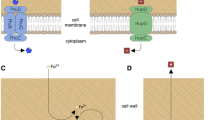Abstract
The in vitro production of hemolysin byListeria monocytogenes, a facultative intracellular bacterial pathogen, was examined as a function of medium iron. There was an inverse relationship between iron and hemolysin production: Hemolysis increased as medium iron concentration decreased. This study offers the first evidence that the in vitro production of hemolysin byListeria monocytogenes is under the control of external iron in growth medium.
Similar content being viewed by others
Literature Cited
Armstrong, A. S., Sword, C. P. 1964. Cellular resistance in listeriosis. Journal of Infectious Diseases114:258–264.
Armstrong, B. A., Sword, C. P. 1966. Electron microscopy ofListeria monocytogenes-infected mouse spleen. Journal of Bacteriology91:1346–1355.
Burn, C. G. 1936. Clinical and pathological features of an infection caused by a new pathogen of the genusListerella. American Journal of Pathology12:341–348.
Cowart, R. E., Marquardt, M. P., Foster, B. G. 1980. The removal of iron and other trace elements from a complex bacteriological medium. Microbios Letters13:117–122.
Garvey, J. S., Cremer, N. E., Sussdorf, D. H. 1977. Methods in immunology, 3rd ed., chapter 41. Reading, Mass.: W. A. Benjamin.
Gill, D. A. 1933. Circling disease. A meningoencephalitis of sheep in New Zealand. Notes on a new species of pathogenic organism. Veterinary Journal89:258–270.
Gill, D. A. 1937. Ovine bacterial encephalitis (circling disease) and the bacterial genusListerella. Australian Veterinary Journal13:46–56.
Holder, I. A., Sword, C. P. 1969. Characterization and biological activity of the monocytosis-producing agent ofListeria monocytogenes. Journal of Bacteriology97:603–611.
Kingdon, G. C., Sword, C. P. 1970. Effects ofListeria monocytogenes hemolysin on phagocytic cells and lysosomes. Infection and Immunity1:356–362.
Kochan, I. 1973. The role of iron in bacterial infections, with special consideration of host-tubercle bacillus interactions. Current Topics in Microbiology and Immunology60:1–30.
Kochkan, I. 1977. Role of iron in the regulation of nutritional immunity, pp. 55–77. In: Raymond, K. N. (ed.), Bioinorganic chemistry II. Washington, D. C.: American Chemical Society.
Mackaness, G. B. 1962. Cellular resistance to infection. Journal of Experimental Medicine116:381–406.
Mackaness, G. B. 1964. The immunological basis of acquired cellular resistance. Journal of Experimental Medicine120:105–120.
Murray, E. D. G., Webb, R. A., Swann, M. B. R. 1926. A disease of rabbits characterized by large mononuclear leucocytosis, caused by a hitherto undescribed bacillusBacterium monocytogenes (n. sp.). Journal of Pathology and Bacteriology29:407–439.
Njoku-Obi, A. N., Jenkins, E. M., Njoku-Obi, J. C., Adams, J., Covington, V. 1963. Production and nature ofListeria monocytogenes hemolysins. Journal of Bacteriology86:1–8.
North, R. J. 1974. T-cell-dependent macrophage activation in cell-mediated anti-Listeria immunity, pp. 210–222. In: Wagner, H., Hahn, H. (eds.), Activation of macrophages. New York: American Elsevier.
Stanley, N. F. 1949. Studies onListeria monocytogenes. I. Isolation of a monocytosis producing agent. Australian Journal of Experimental Biology and Medical Science27:123–131.
Sword, C. P. 1966. Mechanisms of pathogenesis inListeria monocytogenes. I. Influence of iron. Journal of Bacteriology92:536–542.
Weinberg, E. D. 1970. Biosynthesis of secondary metabolites: Role of trace metals, pp. 1–39. In: Rose, A. H., Wilkinson, J. F. (eds.), Advances in microbial physiology. New York: Academic Press.
Weinberg, E. D. 1974. Iron and susceptibility to infectious disease. Science184:952–956.
Weinberg, E. D. 1978. Iron and infection. Microbiological Reviews42:45–66.
Wilder, M. S., Sword, C. P. 1967. Mechanisms of pathogenesis inListeria monocytogenes infection. II. Characterization of listeriosis in the CD-1 mouse and survey of biochemical lesions. Journal of Bacteriology93:531–537.
Author information
Authors and Affiliations
Rights and permissions
About this article
Cite this article
Cowart, R.E., Foster, B.G. The role of iron in the production of hemolysin byListeria monocytogenes . Current Microbiology 6, 287–290 (1981). https://doi.org/10.1007/BF01566878
Issue Date:
DOI: https://doi.org/10.1007/BF01566878




